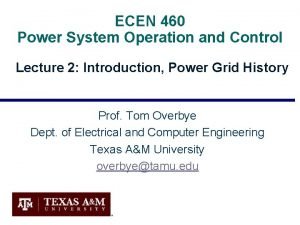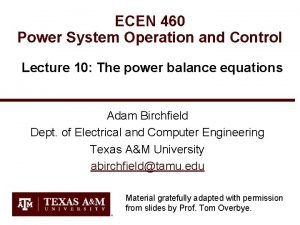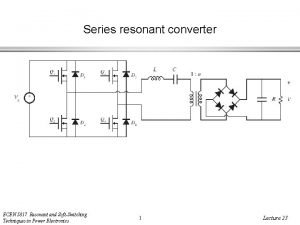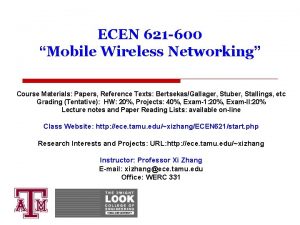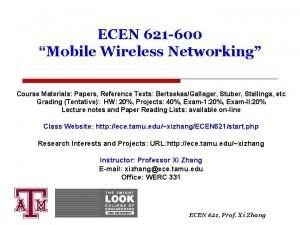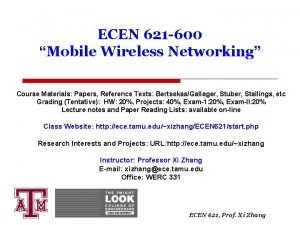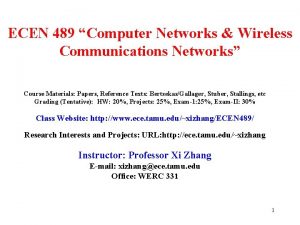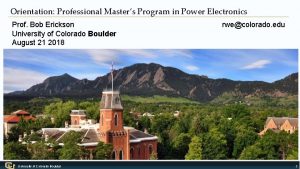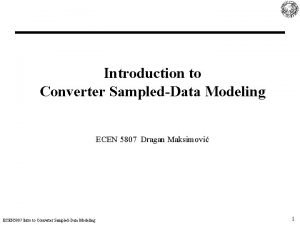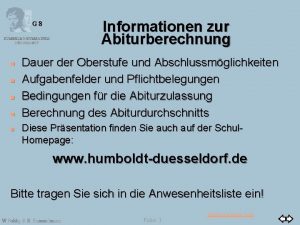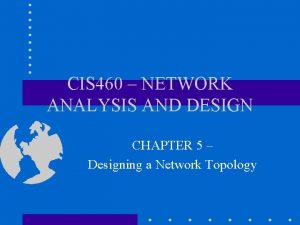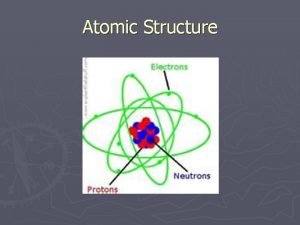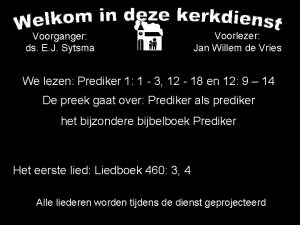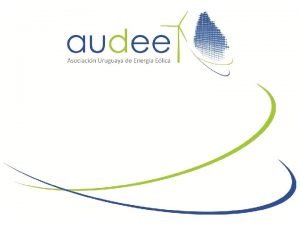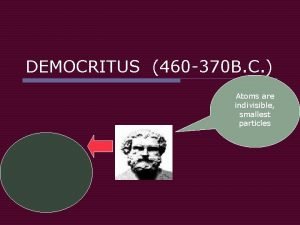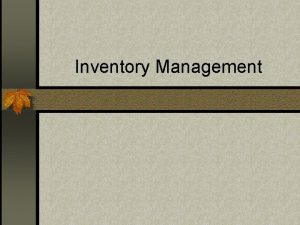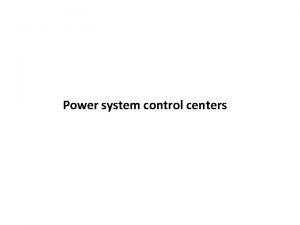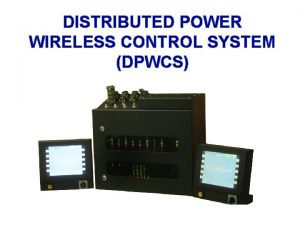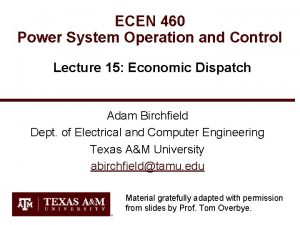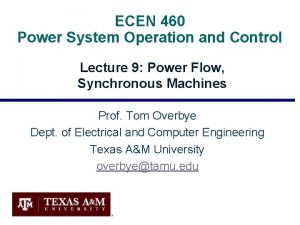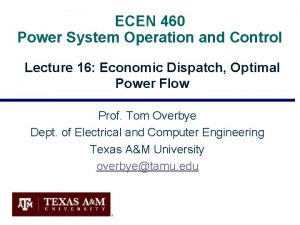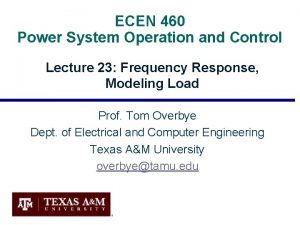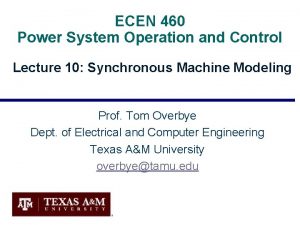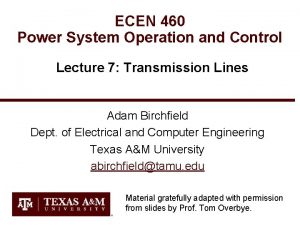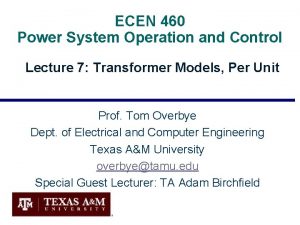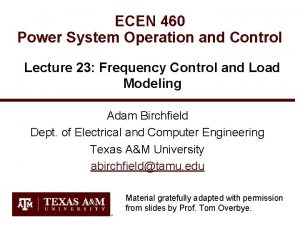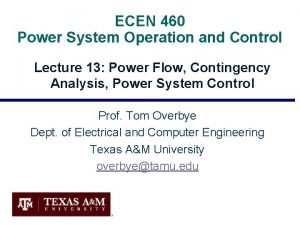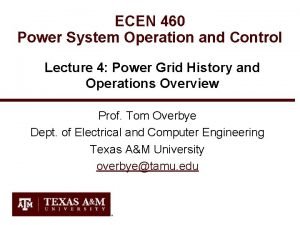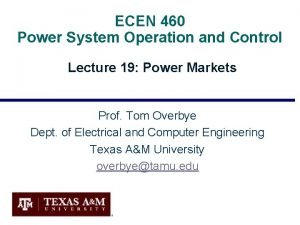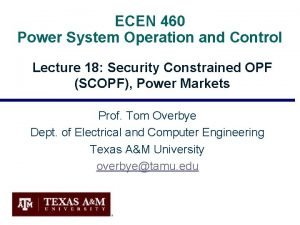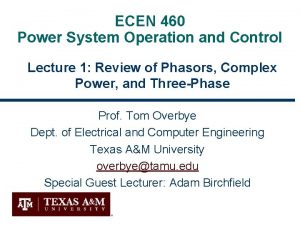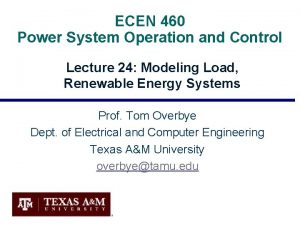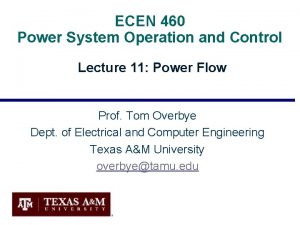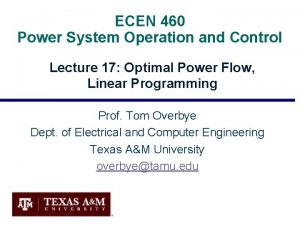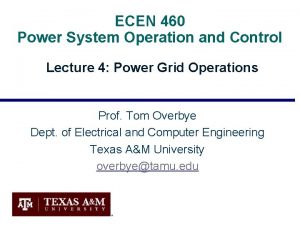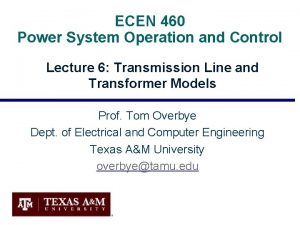ECEN 460 Power System Operation and Control Lecture









































- Slides: 41

ECEN 460 Power System Operation and Control Lecture 3: Power Grid History, Three-Phase Prof. Tom Overbye Dept. of Electrical and Computer Engineering Texas A&M University overbye@tamu. edu

Announcements • Please read Chapters 1, 2, 4. 1 -4. 6 • HW 1 is 2. 9, 22, 28, 43, 48; due Thursday 9/14 • Regular problems (not multiple choice) • Labs will start next week (Sept 11) 1

My Favorite 8/14/2003 Blackout Cartoon! 2

My Favorite Blackout Hoax Photo 3

The Smart Grid • The term “Smart Grid” dates officially to the 2007 “Energy Independence and Security Act”, Title 13 (“Smart Grid”) • • • Use of digital information and control techniques Dynamic grid optimization with cyber-security Deployment of distributed resources including Customer participation and smart appliances Integration of storage including PHEVs Development of interoperability standards 4

Smart Grid Perceptions (Some of Us Like the Term “Smarter”) 5

Renewable Portfolio Standards (September 2012) Source: http: //www. dsireusa. org/ 6

Growth in Solar PV We already covered the growth in wind Source: www. eia. gov/electricity/monthly/update/ 7

Slowing Electric Load Growth The total retail electric sales in 2013 were higher than in 2016 Source: EIA electric power monthly, August 2017 8

Except in Texas! Image source: CEO Perspectives, Bill Magness, ERCOT, May 2017 9

In the News: Symantec Reports Hackers Have Access to US Grid • Electric companies have been targeted by hackers for many years. However, a new attack, by a group Symantec calls Dragonfly, seems to indicate some have possibly gained more operational access to grid systems in the US and Europe • They seek to get access to utility employee credentials through malicious emails and watering hole attacks (compromising websites used by power engineers) • Others cast doubt indicating hackers are far from being able to turn off the lights Sources: www. businessinsider. com/symantec-hackers-sabotage-power-grid-2017 -9, www. symantec. com/connect/blogs/dragonfly-western-energy-sector-targeted-sophisticated-attack-group 10

Modeling Cautions! • "All models are wrong but some are useful, " George Box, Empirical Model-Building and Response Surfaces, (1987, p. 424) – – Models are an approximation to reality, not reality, so they always have some degree of approximation Box went on to say that the practical question is how wrong to they have to be to not be useful • A good part of engineering is deciding what is the appropriate level of modeling, and knowing under what conditions the model will fail • Always keep in mind what problem you are trying to solve! 11

Balanced Three-Phase ( ) Systems • A balanced three-phase ( ) system has – – – three voltage sources with equal magnitude, but with an angle shift of 120 equal loads on each phase equal impedance on the lines connecting the generators to the loads • Bulk power systems are almost exclusively 3 • Single-phase is used primarily only in low voltage, low power settings, such as residential and some commercial 12

Balanced 3 -- No Neutral Current 13

Advantages of Three-Phase Power • Can transmit more power for same amount of wire (twice as much as single phase) • Torque produced by three-phase machines is constant • Three-phase machines use less material for same power rating • Three-phase machines start more easily than singlephase machines 14

Three-Phase Wye Connection • There are two ways to connect 3 systems – – Wye (Y) Delta ( ) 15

Wye Connection Line Voltages Vca Vcn Vab -Vbn Van Vbc (α = 0 in this case) Line to line voltages are also balanced 16

Wye Connection, cont’d • Define voltage/current across/through device to be phase voltage/current • Define voltage/current across/through lines to be line voltage/current 17

Delta Connection Ica Ib Ibc Ic Iab Ia 18

Three-Phase Example Assume a -connected load is supplied from a 3 13. 8 k. V (L-L) source with Z = 100 20 19

Three-Phase Example, cont’d 20

Delta-Wye Transformation 21

Delta-Wye Transformation Proof 22

Delta-Wye Transformation, cont’d 23

Three-Phase Transmission Line 24

Per Phase Analysis • Per phase analysis allows analysis of balanced 3 systems with the same effort as for a single phase system • Balanced 3 Theorem: For a balanced 3 system with – – All loads and sources Y connected No mutual Inductance between phases 25

Per Phase Analysis, cont’d • Then – – – All neutrals are at the same potential All phases are COMPLETELY decoupled All system values are the same sequence as sources. The sequence order we’ve been using (phase b lags phase a and phase c lags phase a) is known as “positive” sequence (negative and zero sequence systems are mostly covered in ECEN 459) 26

Per Phase Analysis Procedure To do per phase analysis 1. Convert all load/sources to equivalent Y’s 2. Solve phase “a” independent of the other phases 3. Total system power S = 3 Va Ia* 4. If desired, phase “b” and “c” values can be determined by inspection (i. e. , ± 120° degree phase shifts) 5. If necessary, go back to original circuit to determine line-line values or internal values. 27

Per Phase Example Assume a 3 , Y-connected generator with Van = 1 0 volts supplies a -connected load with Z = -j through a transmission line with impedance of j 0. 1 per phase. The load is also connected to a -connected generator with Va”b” = 1 0 through a second transmission line which also has an impedance of j 0. 1 per phase. Find 1. The load voltage Va’b’ 2. The total power supplied by each generator, SY and S 28

Per Phase Example, cont’d 29

Per Phase Example, cont’d 30

Per Phase Example, cont’d 31

Per Phase Example, cont’d 32

Power System Operations Overview • Goal is to provide an intuitive feel for power system operation • Emphasis will be on the impact of the transmission system • Introduce basic power flow concepts through small system examples 33

Power System Operations Overview • Goal is to provide an intuitive feel for power system operation • Emphasis will be on the impact of the transmission system • Introduce basic power flow concepts through small system examples 34

Power System Basics • All power systems have three major components: Generation, Load and Transmission/Distribution. • Generation: Creates electric power. • Load: Consumes electric power. • Transmission/Distribution: Transmits electric power from generation to load. – – Lines/transformers operating at voltages above 100 k. V are usually called the transmission system. The transmission system is usually networked. Lines/transformers operating at voltages below 100 k. V are usually called the distribution system (radial). 35

Electric Loads • Can range in size from less than one watt to 10’s of MW • Load are usually aggregated. • The aggregate load changes with time, with strong daily, weekly and seasonal cycles. 36

Electric Load Yearly Variation Data source: FERC 714 filings, 2004 37

Example: PJM Weekly Summer Load Variation, July 2013 38

Example: PJM Weekly Winter Load Variation, February 2015 39

Example: Daily Variation for CA 40
 Ecen 460
Ecen 460 Ecen 460
Ecen 460 Ecen 5817
Ecen 5817 Ecen 621
Ecen 621 Ecen 621
Ecen 621 Ecen 621
Ecen 621 Ecen 489
Ecen 489 Colorado boulder power electronics
Colorado boulder power electronics Ecen 5807
Ecen 5807 Power system dynamics and stability lecture notes
Power system dynamics and stability lecture notes Power system dynamics and stability lecture notes
Power system dynamics and stability lecture notes Zline 667-36
Zline 667-36 01:640:244 lecture notes - lecture 15: plat, idah, farad
01:640:244 lecture notes - lecture 15: plat, idah, farad Active power reactive power apparent power
Active power reactive power apparent power 460 bc atomic structure
460 bc atomic structure Khrihfa hlabu 323
Khrihfa hlabu 323 460 punkte abitur
460 punkte abitur Porsche rental houston
Porsche rental houston Cis 460
Cis 460 Nuclear symbol notation
Nuclear symbol notation Gezang 179
Gezang 179 Historical healthcare figures
Historical healthcare figures 450 yüzlüğe yuvarlama
450 yüzlüğe yuvarlama Sen 460
Sen 460 Multis complex shd 460
Multis complex shd 460 St460ts
St460ts Where was hippocrates born
Where was hippocrates born Hs 460
Hs 460 Democritus 460 bc
Democritus 460 bc Introduction to inventory management
Introduction to inventory management Power angle curve in power system stability
Power angle curve in power system stability Power semiconductor devices lecture notes
Power semiconductor devices lecture notes Switch mode power supply lecture notes
Switch mode power supply lecture notes System control center
System control center Distributed power wireless control system
Distributed power wireless control system Wilkes microprogrammed control unit
Wilkes microprogrammed control unit System design implementation and operation
System design implementation and operation Solar power satellites and microwave power transmission
Solar power satellites and microwave power transmission Actual power
Actual power Define dispersive power of a grating
Define dispersive power of a grating Healthy vs unhealthy relationships
Healthy vs unhealthy relationships Tapestri inc
Tapestri inc
